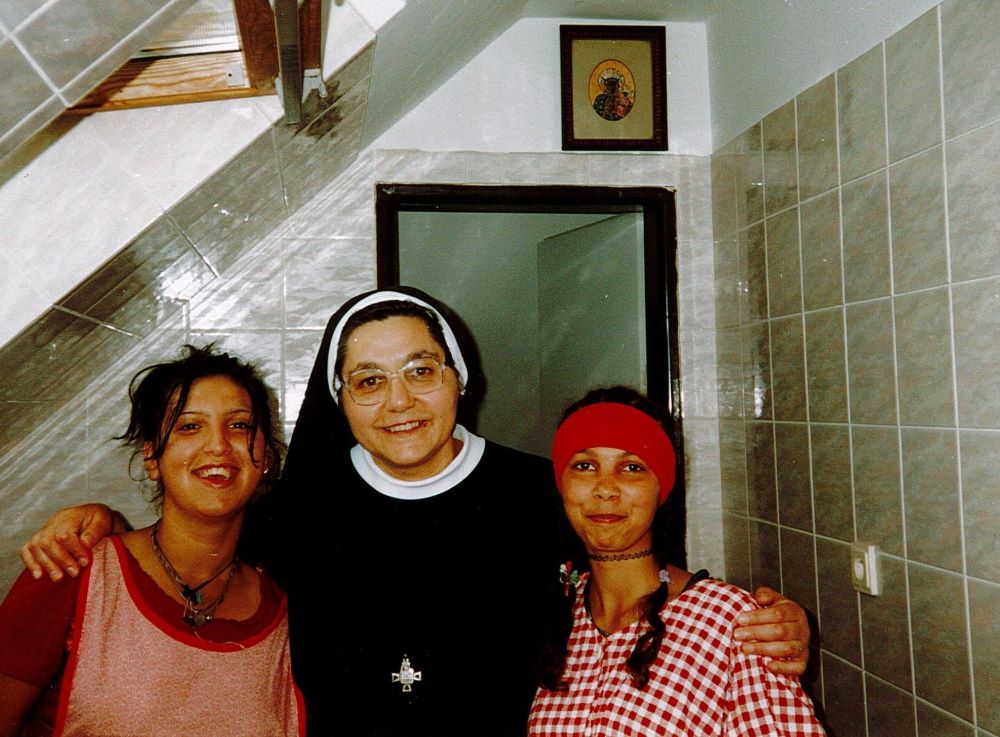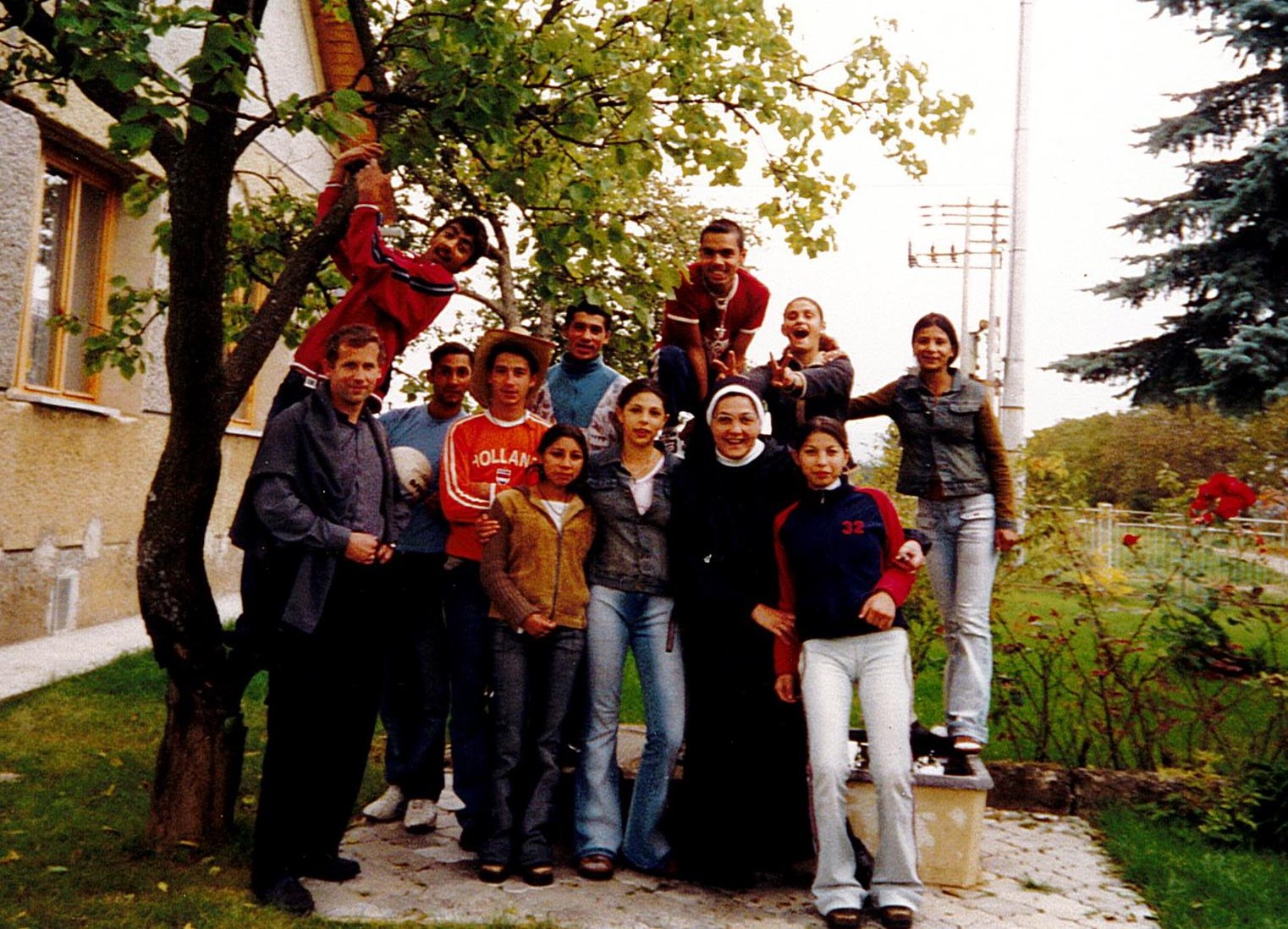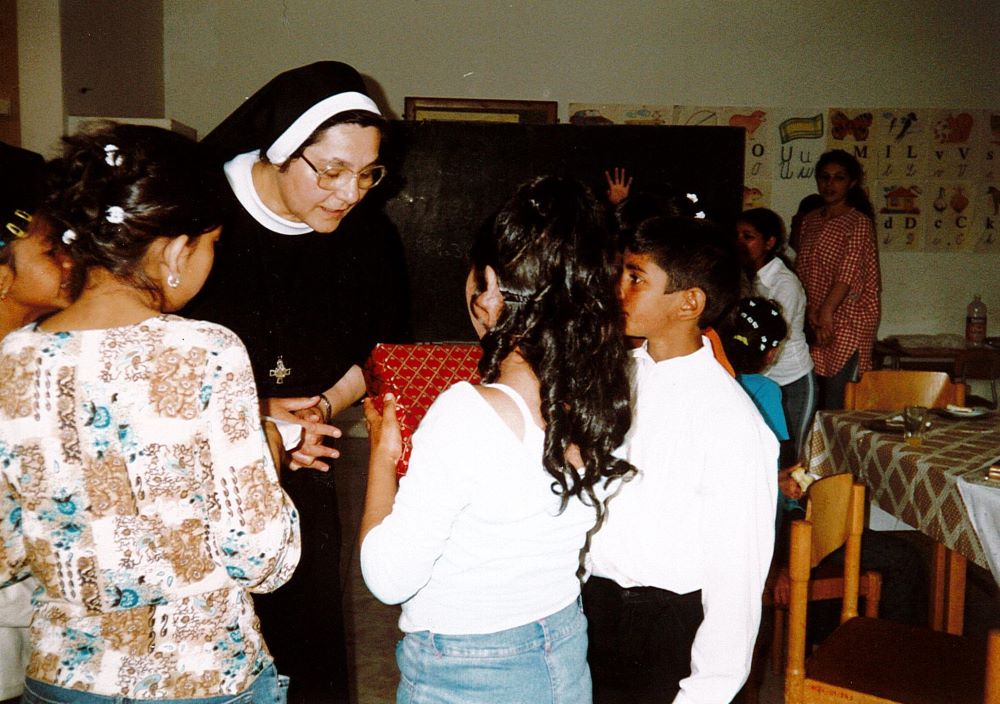
Sr. Atanazia Holubova poses with Romani teenage girls while baking cookies in the Pastoral Center for Romani in Poštarka, Slovakia. (Courtesy of Emanujila Vishka)
In September, I visited the small town of Bardejov in northeastern Slovakia, which has a completely intact medieval town center and holds UNESCO World Heritage status. Near this historical gem, I discovered another treasure within the community of Basilian Sisters, which I would like to share with you.
Shortly after my arrival in the Bardejov community, the convent doorbell rang. At the front door, a Romani woman with a child entered the house. Sr. Atanazia Holubova went to help the woman, and from their conversation behind closed doors, I gathered that they were completing some document together.
The Romani are an Indo-Aryan ethnic group who traditionally led a nomadic, itinerant lifestyle and arrived in Europe around the 13th to 14th century. They are also known as Gypsies. About 67 000 Romani live in Slovakia, according to the country's 2021 census. Many live in Romani slums and ghettos and face challenges related to unemployment and segregation.
Sister Atanazia, who was born into a Romani family herself, has been devoted to helping her people since the beginning of her consecrated life in the Order of St. Basil the Great. This order began in 1972 in communist Slovakia in the underground Greek Catholic Church. She knows firsthand how hard it is to face mistrust and unequal treatment in life, especially in education and work.

Sr. Atanazia Holubova and Salesian Fathers organized a weekend spiritual retreat for Romani teenagers from Poštarka, Slovakia. (Courtesy of Emanujila Vishka)
Today in the Romani slums of Bardejov, known as Poštarka, one can find a church, kindergarten and primary school. Among the activities and projects I am aware of is a choir for children called Devleschere cschave (Children of God). The persistent efforts of Sister Atanazia, in collaboration with the Salesian Fathers, have grown into a wonderful project focused on pastoral work, education and integration for those in need.
Romani children in Poštarka have the opportunity to adapt and learn the Slovak language in the kindergarten and primary school. When Romani children enter primary school with non-Romani peers, many fall behind, get weary and unmotivated. Maria Jevčakova, a teacher with experience working with Romani children in Poštarka, said that the attitude in Romani communities toward children is very unusual: "Children are not considered to need specific attention. They learn by imitating adults, with no particular explanations," she has said. "This is borne out by the fact that Roma culture has no lullabies, fairy tales or games for children." Sister Atanazia and many other people of God are trying to change this reality.
I had the opportunity and a privilege to visit this place and could not help but notice the gratitude pouring from the eyes of children, men and women who came to see Sister Atanazia and her guests. "Sister Atanazia belongs to us. We will not let her go," one Romani boy told me.

Romani children in Bardejov, Slovakia,thank Sr. Atanazia Holubova after their first Communion. (Courtesy of Emanujila Vishka)
In fact, Sister Atanazia told me, as a child, she could not accept being born as a Romani baby because of widespread stereotypes depicting Romani people as "dirty," "stinky," "lazy," "violent," "thieves" and "beggars." She could never relate to that negative image. Her desire to help her people and to challenge that stereotype in society grew each time she passed Romani slums and saw children wandering or playing.
She began her service to the Romani community as a catechist during the communist regime in Slovakia, preparing children for the sacraments. In the following years, her mission grew into various projects, combining education, pastoral and social work (watch video here). I will describe one day of preparing for a Christmas play.
Initially Sister gathered teenagers and young women to bake some cookies. I guess for some of them it was something like baking class, but it was also an engagement in what their younger siblings or kids are doing. Later, Sister gathered children and distributed clothes and toys from humanitarian aid. They read together a Christmas narrative, learned a Christmas song, and at the end of the day the children enjoyed the cookies baked for them. They prayed together before going back to their families. Even though what Sister Atanazia does might seem very casual, it represents a special bond of trust built by years of love and patience.
The Pontifical Council for the Pastoral Care of Migrants and Itinerant People, in "Guidelines for the Pastoral Care of Gypsies," emphasizes that pastoral care for gypsies is challenging.
Merely approaching Gypsies with love and the desire to proclaim the Good News is not sufficient to create a relationship of trust between Gypsies and gağé pastoral agents. History matters, and as a consequence of all the wrongs they have suffered, the Gypsy population has remained suspicious of any initiative that tries to penetrate its world. Overcoming this initial attitude may come about only through concrete manifestations of solidarity, also by sharing its life.
The Guidelines also note that
their points of reference in time and space are not determined by geography or the calendar, but rather by the emotional intensity of a meeting, a job, an incident or a celebration. Their reactions are immediate and guided by intuition rather than abstract thought.
Nevertheless, Sister Atanazia is persuaded that anyone who approaches with love and a willingness to share his or her life with Romani people will succeed in pastoral and social care.
A powerful image that perfectly defines the mission of this Basilian Sister among the Romani is captured in a 1998 Czech Press Photo by David Neff . It shows Sister Atanazia comforting a woman after the loss of her four children in the Jarovnice flood in Slovakia.
Sister Atanazia has faithfully served as an ambassador for the Romani people throughout her life. At age 71, she continues her unwavering ministry of love. For me, she is an inspiration on how to be a Basilian Sister while incorporating one's own background and formation.
Advertisement
As I contemplate the 1998 photo, I cannot help but admire Sister Atanazia's firm gaze, mixed with compassion and sorrow. It seems that her inner gaze is fixed on pain and death itself, with one of her strong arms embracing a mother in despair, holding both her hands in a prayer position. Sister's other hand tenderly comforts a scared girl who sees her mom in such a condition.
How many people in this world, at this very moment, need a Sister Atanazia in their neighborhood, slums, ghettos, loneliness, helplessness and pain? How many more hidden treasures like Sister Atanazia exist in the world, quietly making a difference in the lives of marginalized communities? How many sisters around the world have stories of resilience and love that remain untold?
May Sister Atanazia's life and ministry inspire us to seek opportunities to be a source of hope, love and support in the lives of those who need it the most, just as she has done in her community. May we embrace our own backgrounds and formations, allowing them to enrich our capacity for compassion and service. Together, we can work to make the world a better place for all, one act of love and understanding at a time.



